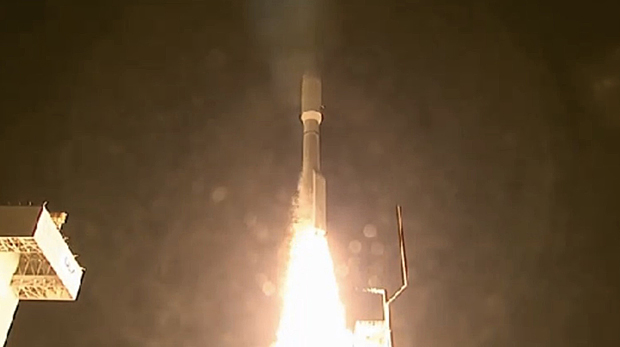Atlas 5 lifts NRO satellite into space
12/12/2014 11:30 PM Filed in: Space News | Military Space
By WILLIAM HARWOOD
CBS News
A powerful United Launch Alliance Atlas 5 rocket thundered away from a California launch pad Friday, boosting a classified National Reconnaissance Office spy satellite into space.
Running a day late because of rainy weather, the rocket's Russian-built RD-180 first stage engine roared to life at 10:19 p.m. EST (GMT-5, 7:19 p.m. local time) followed by ignition of four strap-on solid-fuel boosters.
Spewing a torrent of fiery exhaust, the booster quickly climbed away from its launch pad at Vandenberg Air Force Base northwest of Los Angeles, arcing away to the south toward a polar orbit favored by reconnaissance satellites.
The first stage engine and strap-ons appeared to perform normally during the initial moments of the rocket's climb out of the dense lower atmosphere, but as usual with classified NRO missions, United Launch Alliance ended commentary about four minutes after liftoff and the rest of the ascent was carried out under a communications blackout.
Generating some two million pounds of thrust at liftoff, it was the most powerful Atlas 5 variant ever launched from Vandenberg and only the third overall. NASA's Curiosity Mars rover, launched from Cape Canaveral in 2011, used the same "541" version of the Atlas 5 as did another secret NRO mission launched from Florida earlier this year.
The rocket launched Friday featured a modified Centaur second stage engine making its first flight. Known as the RL10C-1, the hydrogen-fueled engine, originally developed for use with ULA's Delta rockets, generated some 22,890 pounds of thrust and featured a shorter nozzle and upgraded avionics to control propellant mixture ratios.
With a news blackout in place, it was not immediately known how the engine performed during the NROL-35 mission.
CBS News
A powerful United Launch Alliance Atlas 5 rocket thundered away from a California launch pad Friday, boosting a classified National Reconnaissance Office spy satellite into space.
Running a day late because of rainy weather, the rocket's Russian-built RD-180 first stage engine roared to life at 10:19 p.m. EST (GMT-5, 7:19 p.m. local time) followed by ignition of four strap-on solid-fuel boosters.
Spewing a torrent of fiery exhaust, the booster quickly climbed away from its launch pad at Vandenberg Air Force Base northwest of Los Angeles, arcing away to the south toward a polar orbit favored by reconnaissance satellites.
 |
| A United Launch Alliance Atlas 5 rocket climbs away from Vandenberg Air Force Base, Calif., Friday, boosting a classified National Reconnaissance Office satellite toward space. (Credit: ULA webcast) |
The first stage engine and strap-ons appeared to perform normally during the initial moments of the rocket's climb out of the dense lower atmosphere, but as usual with classified NRO missions, United Launch Alliance ended commentary about four minutes after liftoff and the rest of the ascent was carried out under a communications blackout.
Generating some two million pounds of thrust at liftoff, it was the most powerful Atlas 5 variant ever launched from Vandenberg and only the third overall. NASA's Curiosity Mars rover, launched from Cape Canaveral in 2011, used the same "541" version of the Atlas 5 as did another secret NRO mission launched from Florida earlier this year.
The rocket launched Friday featured a modified Centaur second stage engine making its first flight. Known as the RL10C-1, the hydrogen-fueled engine, originally developed for use with ULA's Delta rockets, generated some 22,890 pounds of thrust and featured a shorter nozzle and upgraded avionics to control propellant mixture ratios.
With a news blackout in place, it was not immediately known how the engine performed during the NROL-35 mission.